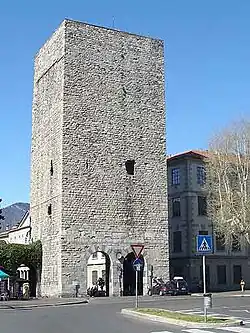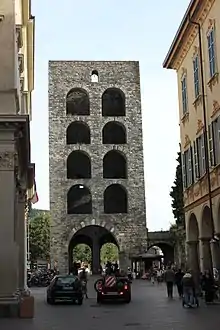Porta Torre
Porta Torre (also known as Torre di Porta Vittoria[3]) is a main fortified tower located in the town of Como, in Lombardy (northern Italy). It is 40 meters high and it was built in 1192, to defend the main entrance of the city.
| Porta Torre | |
|---|---|
Torre di Porta Vittoria | |
 External side of Porta Torre (in front of Piazza Vittoria) | |
 Location within Italy | |
| General information | |
| Status | Completed |
| Type | Defensive tower |
| Architectural style | Romanesque military style |
| Location | Como, Italy |
| Address | Via Cesare Cantù, 22100 |
| Town or city | Como |
| Country | Italy |
| Coordinates | 45°48′23.99″N 9°05′06.7″E |
| Completed | 1192[1] |
| Owner | Comune di Como |
| Height | 40 m.[2] |

History
At the end of the war between Como and Milan in 1127 the Milanese, that won the conflict, tore down the ancient walls of the town, built during the Roman age. After the defeat Como decided to ally with the German Emperor Frederick I (called Barbarossa) to fight the Milanese supremacy in Lombardy. In 1154 the Emperor moved to Italy for the first time, and gave his consent to rebuild the defensive walls of Como (still visible around the town). Some years later, in 1192, the rulers of the town decided to strengthen the fortifications towards south, adding to the newly built walls three big defensive towers. The most impressive one, that assumed the role of main entrance of the town, was placed in the centre of the walls, right in front of the way to Milan, as a symbol of the independence of the town.
In the 14th century the great tower was reinforced with a small ravelin housing some overhead artillery guns[1] and flanked by two other smaller towers of pentagonal shape, which repeated the same pattern with arches open inwards. In the sixteenth century the tower was further reinforced with a semicircular bastion, but all these buildings are no longer visible nowadays.
Description
Porta Torre (that literally means Tower Gate) is one of the better preserved romanesque style military buildings in Italy.[4] The large square-shaped fortification has two entrance arches on the external façade, while just one, wider than the external ones, on the inside.[5] The tower has a massive appearance on the outside, while on the side facing the city is lightened by four orders of coupled arches that corresponded to the four internal floors, which were made of wood and destroyed during the years. This probably had a strategic motivation: if the enemies had managed to occupy the tower they would have been exposed to an attack from the friendly troops from the internal side of the fortification, not fully repaired like the external one.[6] The eight arches on the upper floors are off-axis with respect to the one, much larger one, located on the ground floor.
At a short distance from the tower are the ruins of the ancient Roman walls of the town and a gate, probably dating back to the imperial era. These remains are called Porta Pretoria (literally meaning "main gate" in latin) although, traditionally, the door with this name should be on the east side of the walls.
References
- "Le mura di Como – Capitolo 2 - Mura, porte, torri e giardini" [The walls of Como - Chapter 2 - Walls, gates, towers and gardens] (in Italian). Società Archeologica Comense (Como Archaeologic Society). 3 June 2012. Retrieved 12 March 2018.
- Touring Club Italiano (2001). Laghi d'Italia - Orta, Maggiore, Como, Lugano, Iseo, Garda [Italian Lakes - Orta, Maggiore, Como, Lugano, Iseo, Garda] (in Italian). Milan: Touring Editore. p. 53. ISBN 88365-2214-9.
- Calzecchi Onesti, Carlo; et al. (1931). "Como in Enciclopedia Italiana (1931)". Treccani.it (in Italian). Retrieved 13 March 2018.
- Mascione, Maria (14 October 2016). "Porta Torre". Lombardia Beni Culturali (in Italian). Retrieved 12 March 2018.
- "Porta Torre o torre di Porta Vittoria". Touringclub.it. Touring Club Italiano. Retrieved 12 March 2018.
- Touring Club Italiano. Le provincie di Como e Lecco - Il Lario, le ville, i parchi, Bellagio, Menaggio, Varenna [The provinces of Como and Lecco - The Lake, villas, parks, Bellagio, Menaggio, Varenna] (in Italian). Milan: Touring Club Italiano. p. 156. ISBN 88-365-2919-4.
External links
- "Porta Torre". visitcomo.eu. Retrieved 21 March 2018.
- "Città murata e Porta Torre - Como" [Town walls and Porta Torre - Como]. comolake.com (in Italian). Retrieved 21 March 2018.
- "Mura medievali a Como" [Medieval walls in Como]. medioevo.org (in Italian). Retrieved 21 March 2018.